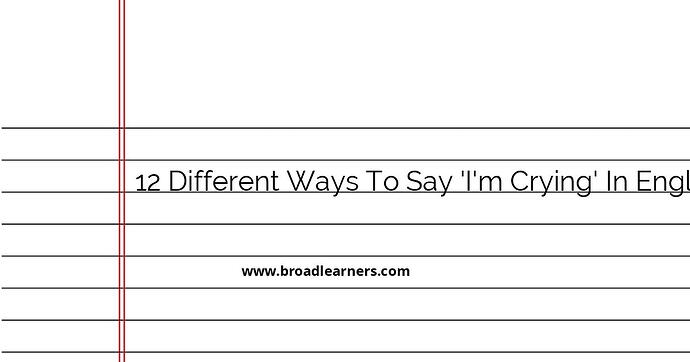Crying is a natural response to emotions like sadness, joy, or frustration. However, saying 'I'm crying' every time can get repetitive. If you want to express your emotions in a more diverse and creative way, here are 12 different ways to say 'I'm crying' in English:
- I'm tearing up
- I'm weeping
- I'm sobbing
- I'm shedding tears
- I'm bawling
- I'm wailing
- I'm in tears
- I'm crying my eyes out
- I'm having a good cry
- I'm choked up
- I'm getting emotional
- I'm feeling teary
Each of these phrases can be used in different contexts depending on the intensity of your emotions. Let's take a closer look at each alternative:
1. I'm tearing up
This phrase suggests that tears are welling up in your eyes, but you may not be openly crying. It is often used to describe a sentimental or touching moment.
Example:
The ending of that movie was so beautiful, it made me tear up.
2. I'm weeping
Weeping implies that you are crying softly and quietly. It typically indicates a deeper level of sadness or grief.
Example:
She couldn't hold back her emotions and started weeping uncontrollably.
3. I'm sobbing
Sobbing refers to loud and uncontrollable crying, usually accompanied by heaving breaths. It suggests intense emotions and distress.
Example:
After receiving the bad news, she fell to the floor and started sobbing.
4. I'm shedding tears
This phrase is a more formal way to say 'I'm crying.' It implies that tears are flowing from your eyes, but you may not be showing strong emotions.
Example:
During the wedding ceremony, the bride's father couldn't help but shed a few tears of joy.
5. I'm bawling
Bawling refers to crying loudly and uncontrollably, often with a lot of noise. It is commonly used to describe crying in a childish or dramatic manner.
Example:
When he didn't get his way, the toddler started bawling in the store.
6. I'm wailing
Wailing is similar to sobbing but with a louder and more mournful sound. It is often associated with expressions of grief or deep sorrow.
Example:
At the funeral, the mourners wailed in sorrow, unable to contain their grief.
7. I'm in tears
This phrase simply means that you are crying. It is a straightforward and commonly used expression to convey your emotional state.
Example:
After hearing the heartbreaking news, she was in tears for hours.
8. I'm crying my eyes out
This phrase emphasizes the intensity of your crying. It suggests that you are crying excessively or for a prolonged period.
Example:
After the breakup, she spent the whole night crying her eyes out.
9. I'm having a good cry
Having a good cry implies that you are intentionally allowing yourself to cry as a way to release pent-up emotions and feel better.
Example:
After a stressful week, she decided to stay home, watch sad movies, and have a good cry.
10. I'm choked up
Being choked up means being on the verge of tears, often due to strong emotions such as love, pride, or gratitude.
Example:
As she walked down the aisle, the bride's father was visibly choked up with emotion.
11. I'm getting emotional
This phrase suggests that you are becoming emotional and may start crying soon. It indicates that you are feeling deeply moved or touched.
Example:
While listening to her favorite song, she could feel herself getting emotional.
12. I'm feeling teary
Feeling teary means that you have the sensation of tears forming in your eyes, even if you are not openly crying. It is often used to describe a sentimental or emotional moment.
Example:
During the graduation ceremony, many parents were feeling teary as they watched their children receive their diplomas.
These alternatives to 'I'm crying' can help you express your emotions in a more nuanced and varied way. Choose the phrase that best reflects the intensity and context of your feelings, and remember that it's okay to let your emotions show.
Did I miss anything? Respond below
